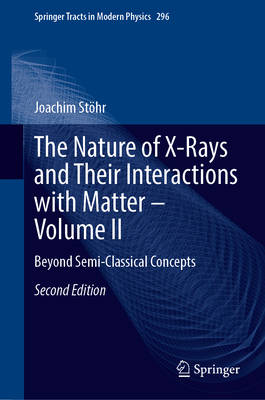
- Afhalen na 1 uur in een winkel met voorraad
- Gratis thuislevering in België vanaf € 30
- Ruim aanbod met 7 miljoen producten
- Afhalen na 1 uur in een winkel met voorraad
- Gratis thuislevering in België vanaf € 30
- Ruim aanbod met 7 miljoen producten
Zoeken
The Nature of X-Rays and Their Interactions with Matter - Volume II
Beyond Semi-Classical Concepts
Joachim Stöhr
€ 305,45
+ 610 punten
Omschrijving
Volume II of the second edition, subtitled Beyond Semi-Classical Concepts, expands the description of x-rays into the framework of quantum optics, rooted in the full theory of light and matter: quantum electrodynamics (QED). Following a brief introduction, the book is organized into three parts and an appendix. Part I explores the description of x-rays and diffraction phenomena within the advanced formalism of quantum optics. The discussion extends conventional quantum mechanics, which treats photons as independent particles, to higher-order quantum states containing multiple photons. A central theme is the emerging paradigm that quantum states with two or more photons can be directly observed in diffraction experiments using multi-photon detection. This makes it possible to overcome constraints of the classical framework, such as the diffraction limit, and to probe novel effects including photon-photon entanglement and interference. Part II presents the quantum formulation of weak photon-matter interactions using the Kramers-Heisenberg-Dirac perturbation framework. This is applied to polarization-dependent, first-principles descriptions of interaction cross sections for x-ray absorption and dichroism, x-ray emission, Thomson scattering, and both resonant elastic (REXS) and inelastic (RIXS) scattering. A new section introduces the derivation of cross sections for two-photon x-ray absorption and ionization. Part III extends the discussion from weak to strong interactions of x-rays with atoms and solids. Topics include the time-dependent transfer of x-ray energy to the electronic system and the lattice, the challenges of sample damage, and the intriguing phenomenon of x-ray transparency. Resonant core-to-valence excitations are analyzed using the optical Bloch equations, revealing effects such as Rabi oscillations of electronic populations and the intensity-dependent emergence of stimulated x-ray scattering. An extensive appendix provides reference materials, including units and physical constants, the calculation of electronic transition matrix elements, and a survey of important quantum states of light and their matrix elements with photon creation and destruction operators encountered in the quantum formulation of diffraction.
Specificaties
Betrokkenen
- Auteur(s):
- Uitgeverij:
Inhoud
- Aantal bladzijden:
- 576
- Taal:
- Engels
- Reeks:
- Reeksnummer:
- nr. 296
Eigenschappen
- Productcode (EAN):
- 9783032076335
- Verschijningsdatum:
- 20/01/2026
- Uitvoering:
- Hardcover
- Formaat:
- Genaaid
- Afmetingen:
- 155 mm x 235 mm

Alleen bij Standaard Boekhandel
+ 610 punten op je klantenkaart van Standaard Boekhandel
Beoordelingen
We publiceren alleen reviews die voldoen aan de voorwaarden voor reviews. Bekijk onze voorwaarden voor reviews.








